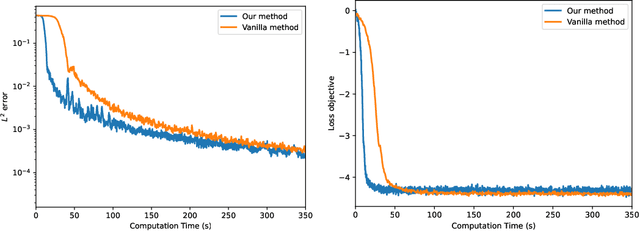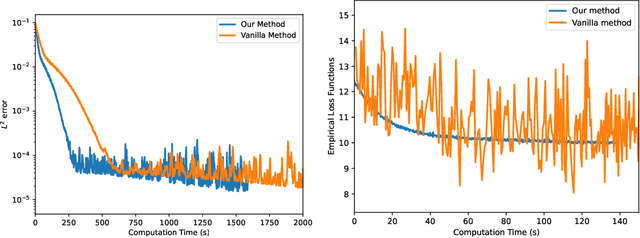Eric Vanden-Eijnden
Multitask Learning with Stochastic Interpolants
Aug 06, 2025Abstract:We propose a framework for learning maps between probability distributions that broadly generalizes the time dynamics of flow and diffusion models. To enable this, we generalize stochastic interpolants by replacing the scalar time variable with vectors, matrices, or linear operators, allowing us to bridge probability distributions across multiple dimensional spaces. This approach enables the construction of versatile generative models capable of fulfilling multiple tasks without task-specific training. Our operator-based interpolants not only provide a unifying theoretical perspective for existing generative models but also extend their capabilities. Through numerical experiments, we demonstrate the zero-shot efficacy of our method on conditional generation and inpainting, fine-tuning and posterior sampling, and multiscale modeling, suggesting its potential as a generic task-agnostic alternative to specialized models.
How to build a consistency model: Learning flow maps via self-distillation
May 24, 2025Abstract:Building on the framework proposed in Boffi et al. (2024), we present a systematic approach for learning flow maps associated with flow and diffusion models. Flow map-based models, commonly known as consistency models, encompass recent efforts to improve the efficiency of generative models based on solutions to differential equations. By exploiting a relationship between the velocity field underlying a continuous-time flow and the instantaneous rate of change of the flow map, we show how to convert existing distillation schemes into direct training algorithms via self-distillation, eliminating the need for pre-trained models. We empirically evaluate several instantiations of our framework, finding that high-dimensional tasks like image synthesis benefit from objective functions that avoid temporal and spatial derivatives of the flow map, while lower-dimensional tasks can benefit from objectives incorporating higher-order derivatives to capture sharp features.
FEAT: Free energy Estimators with Adaptive Transport
Apr 15, 2025Abstract:We present Free energy Estimators with Adaptive Transport (FEAT), a novel framework for free energy estimation -- a critical challenge across scientific domains. FEAT leverages learned transports implemented via stochastic interpolants and provides consistent, minimum-variance estimators based on escorted Jarzynski equality and controlled Crooks theorem, alongside variational upper and lower bounds on free energy differences. Unifying equilibrium and non-equilibrium methods under a single theoretical framework, FEAT establishes a principled foundation for neural free energy calculations. Experimental validation on toy examples, molecular simulations, and quantum field theory demonstrates improvements over existing learning-based methods.
Optimizing Noise Schedules of Generative Models in High Dimensionss
Jan 02, 2025



Abstract:Recent works have shown that diffusion models can undergo phase transitions, the resolution of which is needed for accurately generating samples. This has motivated the use of different noise schedules, the two most common choices being referred to as variance preserving (VP) and variance exploding (VE). Here we revisit these schedules within the framework of stochastic interpolants. Using the Gaussian Mixture (GM) and Curie-Weiss (CW) data distributions as test case models, we first investigate the effect of the variance of the initial noise distribution and show that VP recovers the low-level feature (the distribution of each mode) but misses the high-level feature (the asymmetry between modes), whereas VE performs oppositely. We also show that this dichotomy, which happens when denoising by a constant amount in each step, can be avoided by using noise schedules specific to VP and VE that allow for the recovery of both high- and low-level features. Finally we show that these schedules yield generative models for the GM and CW model whose probability flow ODE can be discretized using $\Theta_d(1)$ steps in dimension $d$ instead of the $\Theta_d(\sqrt{d})$ steps required by constant denoising.
Model-free learning of probability flows: Elucidating the nonequilibrium dynamics of flocking
Nov 21, 2024Abstract:Active systems comprise a class of nonequilibrium dynamics in which individual components autonomously dissipate energy. Efforts towards understanding the role played by activity have centered on computation of the entropy production rate (EPR), which quantifies the breakdown of time reversal symmetry. A fundamental difficulty in this program is that high dimensionality of the phase space renders traditional computational techniques infeasible for estimating the EPR. Here, we overcome this challenge with a novel deep learning approach that estimates probability currents directly from stochastic system trajectories. We derive a new physical connection between the probability current and two local definitions of the EPR for inertial systems, which we apply to characterize the departure from equilibrium in a canonical model of flocking. Our results highlight that entropy is produced and consumed on the spatial interface of a flock as the interplay between alignment and fluctuation dynamically creates and annihilates order. By enabling the direct visualization of when and where a given system is out of equilibrium, we anticipate that our methodology will advance the understanding of a broad class of complex nonequilibrium dynamics.
A Simulation-Free Deep Learning Approach to Stochastic Optimal Control
Oct 07, 2024



Abstract:We propose a simulation-free algorithm for the solution of generic problems in stochastic optimal control (SOC). Unlike existing methods, our approach does not require the solution of an adjoint problem, but rather leverages Girsanov theorem to directly calculate the gradient of the SOC objective on-policy. This allows us to speed up the optimization of control policies parameterized by neural networks since it completely avoids the expensive back-propagation step through stochastic differential equations (SDEs) used in the Neural SDE framework. In particular, it enables us to solve SOC problems in high dimension and on long time horizons. We demonstrate the efficiency of our approach in various domains of applications, including standard stochastic optimal control problems, sampling from unnormalized distributions via construction of a Schr\"odinger-F\"ollmer process, and fine-tuning of pre-trained diffusion models. In all cases our method is shown to outperform the existing methods in both the computing time and memory efficiency.
NETS: A Non-Equilibrium Transport Sampler
Oct 03, 2024Abstract:We propose an algorithm, termed the Non-Equilibrium Transport Sampler (NETS), to sample from unnormalized probability distributions. NETS can be viewed as a variant of annealed importance sampling (AIS) based on Jarzynski's equality, in which the stochastic differential equation used to perform the non-equilibrium sampling is augmented with an additional learned drift term that lowers the impact of the unbiasing weights used in AIS. We show that this drift is the minimizer of a variety of objective functions, which can all be estimated in an unbiased fashion without backpropagating through solutions of the stochastic differential equations governing the sampling. We also prove that some these objectives control the Kullback-Leibler divergence of the estimated distribution from its target. NETS is shown to be unbiased and, in addition, has a tunable diffusion coefficient which can be adjusted post-training to maximize the effective sample size. We demonstrate the efficacy of the method on standard benchmarks, high-dimensional Gaussian mixture distributions, and a model from statistical lattice field theory, for which it surpasses the performances of related work and existing baselines.
Flow Map Matching
Jun 11, 2024Abstract:Generative models based on dynamical transport of measure, such as diffusion models, flow matching models, and stochastic interpolants, learn an ordinary or stochastic differential equation whose trajectories push initial conditions from a known base distribution onto the target. While training is cheap, samples are generated via simulation, which is more expensive than one-step models like GANs. To close this gap, we introduce flow map matching -- an algorithm that learns the two-time flow map of an underlying ordinary differential equation. The approach leads to an efficient few-step generative model whose step count can be chosen a-posteriori to smoothly trade off accuracy for computational expense. Leveraging the stochastic interpolant framework, we introduce losses for both direct training of flow maps and distillation from pre-trained (or otherwise known) velocity fields. Theoretically, we show that our approach unifies many existing few-step generative models, including consistency models, consistency trajectory models, progressive distillation, and neural operator approaches, which can be obtained as particular cases of our formalism. With experiments on CIFAR-10 and ImageNet 32x32, we show that flow map matching leads to high-quality samples with significantly reduced sampling cost compared to diffusion or stochastic interpolant methods.
Sequential-in-time training of nonlinear parametrizations for solving time-dependent partial differential equations
Apr 01, 2024Abstract:Sequential-in-time methods solve a sequence of training problems to fit nonlinear parametrizations such as neural networks to approximate solution trajectories of partial differential equations over time. This work shows that sequential-in-time training methods can be understood broadly as either optimize-then-discretize (OtD) or discretize-then-optimize (DtO) schemes, which are well known concepts in numerical analysis. The unifying perspective leads to novel stability and a posteriori error analysis results that provide insights into theoretical and numerical aspects that are inherent to either OtD or DtO schemes such as the tangent space collapse phenomenon, which is a form of over-fitting. Additionally, the unified perspective facilitates establishing connections between variants of sequential-in-time training methods, which is demonstrated by identifying natural gradient descent methods on energy functionals as OtD schemes applied to the corresponding gradient flows.
Probabilistic Forecasting with Stochastic Interpolants and Föllmer Processes
Mar 20, 2024Abstract:We propose a framework for probabilistic forecasting of dynamical systems based on generative modeling. Given observations of the system state over time, we formulate the forecasting problem as sampling from the conditional distribution of the future system state given its current state. To this end, we leverage the framework of stochastic interpolants, which facilitates the construction of a generative model between an arbitrary base distribution and the target. We design a fictitious, non-physical stochastic dynamics that takes as initial condition the current system state and produces as output a sample from the target conditional distribution in finite time and without bias. This process therefore maps a point mass centered at the current state onto a probabilistic ensemble of forecasts. We prove that the drift coefficient entering the stochastic differential equation (SDE) achieving this task is non-singular, and that it can be learned efficiently by square loss regression over the time-series data. We show that the drift and the diffusion coefficients of this SDE can be adjusted after training, and that a specific choice that minimizes the impact of the estimation error gives a F\"ollmer process. We highlight the utility of our approach on several complex, high-dimensional forecasting problems, including stochastically forced Navier-Stokes and video prediction on the KTH and CLEVRER datasets.
 Add to Chrome
Add to Chrome Add to Firefox
Add to Firefox Add to Edge
Add to Edge